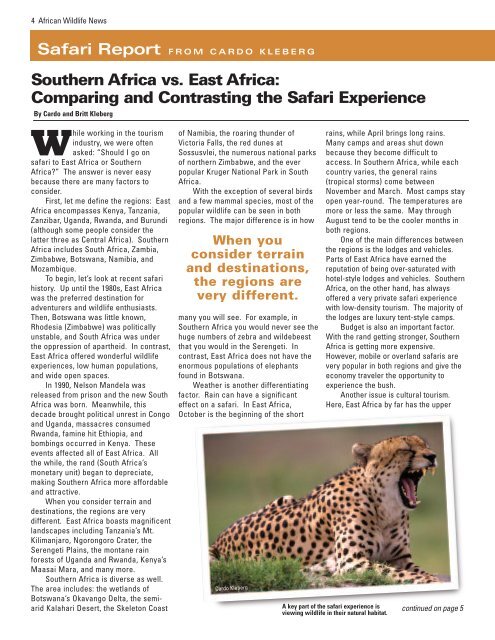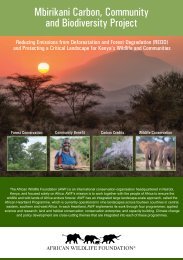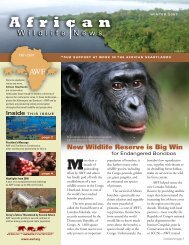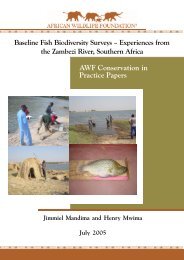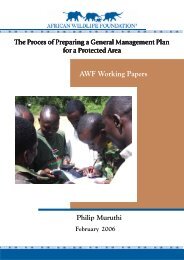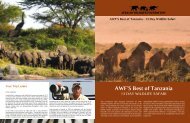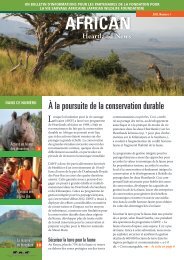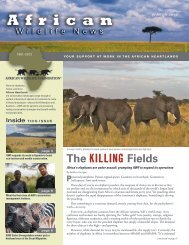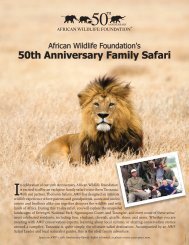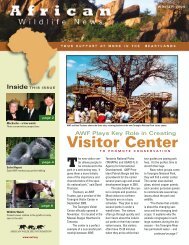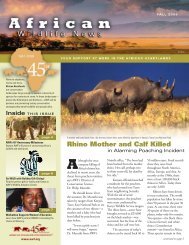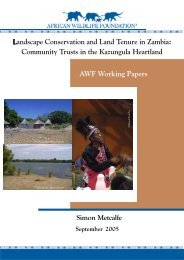Population Increases - African Wildlife
Population Increases - African Wildlife
Population Increases - African Wildlife
Create successful ePaper yourself
Turn your PDF publications into a flip-book with our unique Google optimized e-Paper software.
4 <strong>African</strong> <strong>Wildlife</strong> News<br />
Safari Report FROM CARDO KLEBERG<br />
Southern Africa vs. East Africa:<br />
Comparing and Contrasting the Safari Experience<br />
By Cardo and Britt Kleberg<br />
While working in the tourism<br />
industry, we were often<br />
asked: “Should I go on<br />
safari to East Africa or Southern<br />
Africa?” The answer is never easy<br />
because there are many factors to<br />
consider.<br />
First, let me define the regions: East<br />
Africa encompasses Kenya, Tanzania,<br />
Zanzibar, Uganda, Rwanda, and Burundi<br />
(although some people consider the<br />
latter three as Central Africa). Southern<br />
Africa includes South Africa, Zambia,<br />
Zimbabwe, Botswana, Namibia, and<br />
Mozambique.<br />
To begin, let’s look at recent safari<br />
history. Up until the 1980s, East Africa<br />
was the preferred destination for<br />
adventurers and wildlife enthusiasts.<br />
Then, Botswana was little known,<br />
Rhodesia (Zimbabwe) was politically<br />
unstable, and South Africa was under<br />
the oppression of apartheid. In contrast,<br />
East Africa offered wonderful wildlife<br />
experiences, low human populations,<br />
and wide open spaces.<br />
In 1990, Nelson Mandela was<br />
released from prison and the new South<br />
Africa was born. Meanwhile, this<br />
decade brought political unrest in Congo<br />
and Uganda, massacres consumed<br />
Rwanda, famine hit Ethiopia, and<br />
bombings occurred in Kenya. These<br />
events affected all of East Africa. All<br />
the while, the rand (South Africa’s<br />
monetary unit) began to depreciate,<br />
making Southern Africa more affordable<br />
and attractive.<br />
When you consider terrain and<br />
destinations, the regions are very<br />
different. East Africa boasts magnificent<br />
landscapes including Tanzania’s Mt.<br />
Kilimanjaro, Ngorongoro Crater, the<br />
Serengeti Plains, the montane rain<br />
forests of Uganda and Rwanda, Kenya’s<br />
Maasai Mara, and many more.<br />
Southern Africa is diverse as well.<br />
The area includes: the wetlands of<br />
Botswana’s Okavango Delta, the semiarid<br />
Kalahari Desert, the Skeleton Coast<br />
of Namibia, the roaring thunder of<br />
Victoria Falls, the red dunes at<br />
Sossusvlei, the numerous national parks<br />
of northern Zimbabwe, and the ever<br />
popular Kruger National Park in South<br />
Africa.<br />
With the exception of several birds<br />
and a few mammal species, most of the<br />
popular wildlife can be seen in both<br />
regions. The major difference is in how<br />
When you<br />
consider terrain<br />
and destinations,<br />
the regions are<br />
very different.<br />
many you will see. For example, in<br />
Southern Africa you would never see the<br />
huge numbers of zebra and wildebeest<br />
that you would in the Serengeti. In<br />
contrast, East Africa does not have the<br />
enormous populations of elephants<br />
found in Botswana.<br />
Weather is another differentiating<br />
factor. Rain can have a significant<br />
effect on a safari. In East Africa,<br />
October is the beginning of the short<br />
Cardo Kleberg<br />
rains, while April brings long rains.<br />
Many camps and areas shut down<br />
because they become difficult to<br />
access. In Southern Africa, while each<br />
country varies, the general rains<br />
(tropical storms) come between<br />
November and March. Most camps stay<br />
open year-round. The temperatures are<br />
more or less the same. May through<br />
August tend to be the cooler months in<br />
both regions.<br />
One of the main differences between<br />
the regions is the lodges and vehicles.<br />
Parts of East Africa have earned the<br />
reputation of being over-saturated with<br />
hotel-style lodges and vehicles. Southern<br />
Africa, on the other hand, has always<br />
offered a very private safari experience<br />
with low-density tourism. The majority of<br />
the lodges are luxury tent-style camps.<br />
Budget is also an important factor.<br />
With the rand getting stronger, Southern<br />
Africa is getting more expensive.<br />
However, mobile or overland safaris are<br />
very popular in both regions and give the<br />
economy traveler the opportunity to<br />
experience the bush.<br />
Another issue is cultural tourism.<br />
Here, East Africa by far has the upper<br />
A key part of the safari experience is<br />
viewing wildlife in their natural habitat.<br />
continued on page 5


